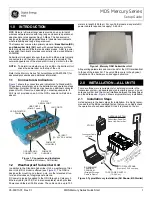
8
Meanwhile, a portion of the output of 11.7 MHz crystal
X1003
is multiplied fourfold by
Q1043
(
2SC4400
) to pro-
vide the 46.8 MHz second local signal, then applied to the
IF IC
Q1047
. Within the IF IC
Q1047
, the 46.8 MHz second
local signal is mixed with the 47.25 MHz “Sub” band first
local signal to produce the 450 kHz “Sub” band second IF.
The 450 kHz “Sub” band second IF is delivered to the
ceramic filter
CF1003
(
CFWM450E
) which strips away all
but the desired signal, then passed through the IF ampli-
fier within
Q1047
to the ceramic discriminator
CD1002
(
CDBM450C24
) which removes any amplitude variations
in the 450 kHz IF signal before detection of speech.
The demodulated “Sub” band audio is passed through the
de-emphasis network, audio switch
D1048
(
DAN222
),
low-pass filter network (consisting of
Q1053
(
NJM2902V
)
and associated circuitry) and the high-pass filter network
(consisting of
Q1054
(
NJM2904V
) and associated circuit-
ry). The filtered audio signal is passed through the audio
volume control IC
Q1063
(
M511312FP
), which adjusts the
audio sensitivity to compensate for audio level variations,
then is delivered to the audio switch
Q1066
and
Q1067
(both
TC4W66FU
).
When the internal speaker is selected, the audio signal is
amplified by
Q1069
(
TDA7233D
) then applied to the in-
ternal loudspeaker. When the external speaker is select-
ed, the audio signal is amplified by
Q1068
(
LA4425A
),
then it passes through the
EXT SP
jack to the external loud-
speaker.
Squelch Control
“Main” Band
When no carrier is being received on the “Main” band,
noise at the output of the detector stage in
Q1044
is am-
plified and band-pass filtered by the noise amp section of
Q1044
. The resulting DC voltage is delivered to pin 5 of
main CPU
Q1104
(
M38268MCL
), which compares the
squelch threshold level to that which set by the front pan-
el
SQL
knob.
While no carrier is being received on the “Main” band,
pin 2 of
Q1105
remain “low,” to disable the audio output
from the speaker.
“Sub” Band
When no carrier is being received on the “Sub” band, noise
at the output of the detector stage in
Q1047
is amplified
and band-pass filtered by the noise amp section of
Q1047
.
The resulting DC voltage is delivered to pin 2 of main
CPU
Q1104
, which compares the squelch threshold level
to that which set by the front panel
SQL
knob.
While no carrier is being received on the “Right” band,
pin 15 of
Q1105
remain “low,” to disable the audio out-
put from the speaker.
Transmitter Signal Path
AF Signal
The speech signal from the microphone is passed through
the
MIC
jack
J3003
to the AF amplifier
Q3001
(
NJM2904V
)
on the PANEL-SUB UNT. The amplified speech signal is
passed through the panel separation jacks
J3001
and
J1005
to the MAIN Unit. On the MAIN UNIT, the speech signal
is delivered to the limiting amplifier
Q1074
(
NJM2902V
) to
prevent over-modulation, then is delivered to a low-pass
filter network consisting of
Q1074
and associated circuitry.
430 MHz Signal
The adjusted speech signal from
Q1074
is passed through
transistor switch
Q1114, Q1115
(both
DTC144EE
) to var-
actor diodes
D1079
(
HVC375B
) and
D1080
(
HVC350B
),
which frequency modulate the transmitting VCO, made
up of UHF-VCO/B
Q1116
(
2SC5006
) and
D1081
(
HSC277
).
The modulated transmit signal is passed through buffer
amplifiers
Q1117, Q1118
and
Q1119
(all
2SC5006
) and
diode switches
D1099, D1101
(both
HSC277
) to the pre-
drive amplifier
Q1132
(
2SK2596
).
The amplified transmit signal from
Q1132
is passed
through diode switch
D1106
(
HSC277
) and the driver am-
plifier
Q1134
(
RD07MVS1
) to the diode switch
D1107
(
HSC277
), then finally amplified by power amplifier
Q1135
(
RD70HVF1
), providing up to 35 Watts of power
output. These three stages of the power amplifier’s gain
are controlled by the APC circuit.
The 35-Watt RF signal is passed through a high-pass fil-
ter network to the antenna switch
D1118
,
D1119
, and
D1120
(all
UM9957F
), then passed through a low-pass
filter network and another high-pass filter network to the
ANT jack.
144 MHz Signal
The adjusted speech signal from Q1074 is passed through
the transistor switch
Q1114, Q1115
(both
DTC144EE
) to
varactor diodes
D1082
and
D1085
(both
HVC365
), which
frequency modulate the transmitting VCO, made up of
VHF-VCO/B
Q1120
(
2SC5374
) and
D1083
(
HVC131
).
The modulated transmit signal is passed through buffer
amplifiers
Q1121
and
Q1122
(both
2SC5374
) and diode
switches
D1089
and
D1102
(both
HSC277
) to the pre-drive
amplifier
Q1132
(
2SK2596
).
The amplified transmit signal from
Q1132
is passed
through the diode switch
D1105, D1106
(both
HSC277
)
and the driver amplifier
Q1134
(
RD07MVS1
) to diode
switch
D1108
(
RLS135
), then finally amplified by power
amplifier
Q1135
(
RD70HVF1
) up to 50 Watts of power
output. These three stages of the power amplifier’s gain
are controlled by the APC circuit.
Circuit Description
Содержание FT-8800E
Страница 4: ...4 Exploded View Miscellaneous Parts Note...
Страница 5: ...Block Diagram 5...
Страница 6: ...Block Diagram 6 Note...
Страница 16: ...16 Note...
Страница 18: ...MAIN Unit 18 Note...
Страница 44: ...44 MAIN Unit Note...
Страница 45: ...45 PANEL Unit Circuit Diagram...
Страница 50: ...50 PANEL Unit Note...
Страница 51: ...51 PANEL SUB Unit Circuit Diagram...









































